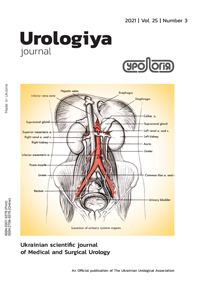Long term outcomes of the management of ureterovaginal fistula after obstetric and gynecological procedures
DOI:
https://doi.org/10.26641/2307-5279.25.4.2021.253249Keywords:
ureteral injury, ureterovaginal fistula, minimally invasive surgical treatment, ureteroscopy, ureteral stenting, percutaneous puncture nephrostomyAbstract
Between the year 2010 to 2021, 25 patients noticed involuntary leakage of urine from the vagina within 10-40 days after surgical procedures in obstetric (n=2) or gynecological (n=23) departments. The average age on the date of the surgical management of the women was 45.6 years (from 22 to 61). Operations in 15 of the patients were performed via laparatomic access, transvaginal approach was used in 3, and the remaining 7 underwent laparoscopic surgical procedures, and the most frequent operation was hysterectomy done in 20 (80.0%) cases. The patients were referred to the urology center under the department of Belarusian State Medical University for further examination and possible management. Investigation results revealed, that, all women had a combination of ureteral injury (UI) and uretero-vaginal fistula (UVF).Taking into account the clinic’s experience in the treatment of such patients, their management was divided into 2 stages. At the first stage, two patients underwent reconstructive repair surgeries (ureteroneocystoanastomosis) via an open access within 1-2 days after admission into the urology hospital, 14 women had D-J stent insertion, percutaneous nephrostomy (PCN) was placed in 8 cases, and a D-J stent + PCN tube inserted in 1. Analysis during a follow up inpatient study after 3 months, revealed the 2 patients who underwent reconstructive repair surgeries and the 8 after removal of stents had a good treatment outcomes. Fifteen patients underwent operations in the 2nd stage: endoscopic management was carried out in 7 patients (dilation (bougienage) of ureteral stricture + D-J stent placement, endoureteroplasty with endotomic stent placement), and reconstructive repair surgeries (ureteroneocystoanastomosis) via open access in 8 patients. Long-term results were followed up in all patients within the period from 18 months to 4 years. Good management outcomes were achieved in 19 (76.0%) patients, and satisfactory outcomes in 6 (24.0%). Endoscopic treatment of patients of the study group showed high efficiency, its usage in 15 (60.0%) cases, helped in restoring ureteral patency and adequate urodynamics on the side of the injury using minimally invasive technologies. All patients after surgical treatment of UI and UVF need a long-term follow-up.
References
Ade-Ojo I.P., Tijani O. A Review on the Etiology, Prevention, and Management of Ureteral Injuries During Obstetric and Gynecologic Surgeries. Int J Womens Health. 2021. Vol. 13. P. 895–902. Doi: 10.2147/IJWH.S330060.
Aguilera A., Rivas J.G, Quintana Franco L.M., Quesada-Olarte J., Carrion D.M., Martнnez-Piсeiro L. Ureteral injury during abdominal and pelvic surgery: Immediate versus deferred repair. Cent Eur J Urol. 2019. Vol. 72, No. 3. P. 312–318. Doi: 10.5173/ceju.2019.1782.
Blackwell R.H., Kirshenbaum E.J., Shah A.S., Kuo P.C., Gupta G.N., Turk T.M.T. Complications of recognized and unrecognized iatrogenic ureteral injury at time of hysterectomy: A population based analysis. J Urol. 2018. Vol. 199, No. 6. P. 1540–1545. Doi: 10.1016/j.juro.2017.12.067.
Dallas K.B., Rogo-Gupta L., Elliott C.S. Urologic injury and fistula after hysterectomy for benign indications. Obst Gynecol. 2019. Vol. 134, No. 2. P. 241–249. Doi: 10.1097/AOG.0000000000003353.
Elawdy M.M., Osman Y., Awad B., El-Mekresh M., El-Halwagy S. Iatrogenic ureteral injuries: a case series analysis with an emphasis on the predictors of late ureteral strictures and unfavorable outcome in different surgical specialties. Int Urogynecol J. 2020. No. 11. Doi: 10.1007/s00192-020-04578-w.
Fontana F., Piacentino F., Ossola C., Casarin J., Coppola A., Cromi, A., et al. Diagnostic and Interventional Radiology Management of Ureteral Iatrogenic Leakage after Gynecologic Surgery. Diagnostics (Basel). 2021. Vol. 11, No. 5. P. 750. Doi: 10.3390/diagnostics11050750.
Hwang J.H., Kim B.W. Laparoscopic radical hysterectomy has higher risk of perioperative urologic complication than abdominal radical hysterectomy: a meta-analysis of 38 studies. Surg Endosc. 2020. Vol. 34, No. 4. P. 1509–1521. Doi: 10.1007/s00464-020-07366-1.
Jacob G.P., Vilos G.A., Al Turki F., Bhangav G., Abu-Rafea B., Vilos A.G., et al. Ureteric Injury During Gynaecological Surgery - Lessons from 20 Cases in Canada. Facts Views Vis Obgyn. 2020. Vol. 12, No. 1. P. 31–42.
Macciт A., Chiappe G., Kotsonis P., Lavra F., Sanna E., Collu I. et al. Feasibility and safety of total laparoscopic hysterectomy for uteri weighing from 1.5 kg to 11.000 kg. Arch Gynecol Obstet. 2021. Vol. 303, No. 1. P. 169–179. Doi: 10.1007/s00404-020-05799-6.
Morey A.F., Broghammer J.A., Hollowell C.M.P., McKibben M.J., Souter L. Urotrauma Guideline 2020: AUA Guideline. J Urol. 2021. Vol. 205, No. 1. P. 30–35. Doi: 10.1097/JU.0000000000001408.
Shapiro R., Fuller K., Wiseman B., Bell C., Wu G., Mannanl R., et al. Factors in delay of diagnosis of gynecologic ureteral injuries at a rural academic hospital. Int Urogynecol J. 2020. Vol. 31, No. 2. P. 359–363.
Visconti F., Quaresima P., Rania E., Palumbo A.R., Micieli M., Zullo F., et al. Difficult caesarean section: A literature review. Eur J Obstet Gynecol Reprod Biol. 2020. Vol. 246. P. 72–78.
Wong J.M.K., Bortoletto P., Tolentino J., Jung M.J., Milad M.P. Urinary Tract Injury in Gynecologic Laparoscopy for Benign Indication: A Systematic Review. Obstet Gynecol. 2018. Vol. 131, No. 1. P. 100–108. Doi: 10.1097/AOG.0000000000002414.
Downloads
Published
Issue
Section
License
Стаття повинна мати візу керівника та офіційне направлення від установи, з якої виходить стаття (з круглою печаткою), і вказівкою, чи є стаття дисертаційною, а також у довільній формі на окремому аркуші - відомості про авторів (прізвище, ім’я, по батькові, посада, вчений ступінь, місце роботи, адреса, контактні телефони, E-mail).
Стаття повина бути підписана всіма авторами, які укладають з редакцією договір пропередачу авторських прав (заповнюється на кожного автора окремо з оригінальним підписом). За таких умов редакція має право на її публікацію та розміщення на сайті видавництва.

